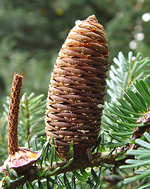|
||||||
|
ABIES. Firs. [Pinaceae] |
|
|
Six species of Abies are recorded in Britain. All are introduced and include European Silver-fir (A. alba). The BSBI provide a downloadable plant crib for conifers. Four British miners are recorded on Abies. A key to the European miners recorded on Abies is provided in Bladmineerders van Europa. |
|
Key for the identification of the known mines of British |
1a > Leaf miner and case-bearer: The larva lives in a silken tube, covered with fragments of bark and lichen on the bark of the older part of a branch. From this tube the larva mines the basal half of a number of leaves. The larva moults in the tube, and pupates in a side branch of it. |
|
Batrachedra pinicolella (Zeller, 1839) [Lepidoptera: Batrachedridae]. |
1b > Leaf miner, but not a case-bearer. |
2a > Leaf-miner: The larva spins a number of needles together in a more or less conical spinning, then mines out one needle after another. The larva enters and leaves a needle through the same opening, mostly in the distal half of the needle. Most frass is ejected, part of it is trapped in the spinning. During feeding the larva pauses to rest in the mine. Most mines in the older needles. Larval body light green; head, pronotum and anal plate light brown; anal comb present, brown, with 4-7 prongs; thoracic legs green; pinacula brown. Pupation external. |
|
Epinotia fraternana (Haworth, 1811) [Lepidoptera: Tortricidae]. |
2b > Leaf-miner: Groups of young needles are completely mined out by the young larvae. Between the needles only a few strands of silk (often also bud scales are trapped in the silk). Later in summer the larva lives free among spun needles. Larva light greenish, with black brown head and pronotum. Anal comb present, c. 6 prongs. Pinacula moderately large, concolorous with the integument. Prolegs with c. 45 crochets in a double row. |
|
Epinotia pygmaeana (Hübner, 1799) [Lepidoptera: Tortricidae]. |
2c > Leaf-miner: Eggs are deposited in groups of 4-5 on top of the midrib of a young needle. The larva penetrates a needle through an oval opening made in the lower half of a leaf, eats its way up to the tip, then down again, finally leaving the leaf through the same opening. A number of needles are mined in this way. The crossing is protected by spinning between the needles. After a first moult the larva begins to mine less young leaves. Older larvae live free among spun needles.Head black or yellowish brown with black sides; pronotum black. Body pale yellowish to greyish green; pinacula inconspicuous. |
|
Epinotia subsequana (Haworth, 1811) [Lepidoptera: Tortricidae]. |
| Last updated 30-Jun-2019 Brian Pitkin | ||

